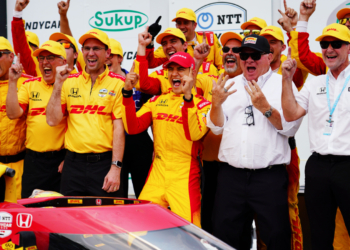Force India’s financial future isn’t in jeopardy according to deputy team principal Bob Fernley, despite the team’s name featuring heavily when it comes to talking about Formula 1’s financial problems.
Force India, Lotus and Sauber are pushing for the sport to change the way it operates by imposing budget restrictions as well as looking at the way it divides prize money in light of Caterham and Marussia’s collapse.
“Our main goal was to try to save money by doing cost control, it wasn’t asking for money,” said Fernley. “You’ve got costs running out of control and you’ve got income that is totally inequitably split, there’s something amiss somewhere. Now we know what the game is, we can work with it.
“From our point of view we’re quite comfortable. The last few weeks have now exposed what the game plan is. We just want to make sure that we stay a constructor and we will work hard to do that and be competitive.”
Whilst Fernley admits costs have spiralled recently, particularly the rise in engine costs thanks to the new hybrid-V6, Force India’s budget is as healthy as ever.
“Our costs have gone from let’s say $10m to $30m plus, in the order of that area. So our powertrain is significantly more expensive. If you can’t get costs under control and then you’ve got teams failing … even Williams with the wonderful, wonderful job that they’ve done; posting a £20m loss? It’s not all good.
“From our point of view – certainly Force India’s point of view – our budgets are as good as they have been for the last seven years. We can run, what you would like to have is more comfort to be able to do it properly.”
#BeyondTheGrid: Responsible Driving – with Sergio Perez and Smirnoff
Force India’s financial future isn’t in jeopardy according to deputy team principal Bob Fernley, despite the team’s name featuring heavily when it comes to talking about Formula 1’s financial problems.
Force India, Lotus and Sauber are pushing for the sport to change the way it operates by imposing budget restrictions as well as looking at the way it divides prize money in light of Caterham and Marussia’s collapse.
“Our main goal was to try to save money by doing cost control, it wasn’t asking for money,” said Fernley. “You’ve got costs running out of control and you’ve got income that is totally inequitably split, there’s something amiss somewhere. Now we know what the game is, we can work with it.
“From our point of view we’re quite comfortable. The last few weeks have now exposed what the game plan is. We just want to make sure that we stay a constructor and we will work hard to do that and be competitive.”
Whilst Fernley admits costs have spiralled recently, particularly the rise in engine costs thanks to the new hybrid-V6, Force India’s budget is as healthy as ever.
“Our costs have gone from let’s say $10m to $30m plus, in the order of that area. So our powertrain is significantly more expensive. If you can’t get costs under control and then you’ve got teams failing … even Williams with the wonderful, wonderful job that they’ve done; posting a £20m loss? It’s not all good.
“From our point of view – certainly Force India’s point of view – our budgets are as good as they have been for the last seven years. We can run, what you would like to have is more comfort to be able to do it properly.”
#BeyondTheGrid: Responsible Driving – with Sergio Perez and Smirnoff






